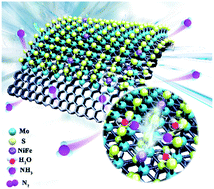Unique hollow Ni–Fe@MoS2 nanocubes with boosted electrocatalytic activity for N2 reduction to NH3†
Abstract
Nanostructure tailoring is considered as an efficient strategy to design high-performance electrocatalysts for improving electrocatalytic properties by exposing more active sites and promoting rapid electron transfer. Unfortunately, nanomaterials with a well-constructed morphology for the nitrogen reduction reaction (NRR) under ambient conditions are insufficient, and the yield rate and faradaic efficiency are still not high. Herein, NiFe–MoS2 nanocubes (NiFe@MoS2 NCs) are successfully synthesized derived from the corresponding Prussian blue analog self-templating strategy. Owing to its four-pointed star face-dependent hollow structure and trimetallic synergistic interactions, it largely exposes abundant active sites, making it present superb electrocatalytic performance for N2 conversion to NH3. In a 0.1 M Na2SO4 electrolyte, these as-prepared Ni–Fe@MoS2 NCs exhibit a significant NH3 yield of 128.17 μg h−1 mgcat.−1 and a satisfactory faradaic efficiency of 11.34% at −0.3 V vs. reversible hydrogen electrode (RHE) operation at 40 °C. The stability of the catalyst was determined by performing 15 hour continuous N2 reduction with a constant current density. The possible NRR catalytic paths, mechanism and electron transfer paths are elucidated in detail by in situ electrochemical-Fourier transform infrared spectroscopy combined with density functional theory calculations. This work offers new inspirations to the development of various cost-effective electrocatalysts for N2 fixation.



 Please wait while we load your content...
Please wait while we load your content...